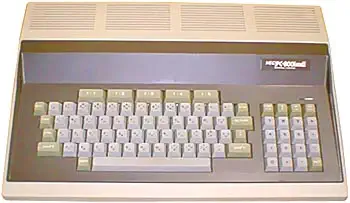NEC PC 8001 MK 2
A higher-performance, more graphically capable revision of the PC-8001, the Mark II debuted in March 1983 for a price of 123,000 yen.
While its most obvious improvement was in its graphical capabilities, the Mark II also included an internal 5.25" floppy disk interface as well as two internal expansion slots, doing away with the need for an "expansion box" to permit upgrades.
The internal BASIC was changed as well, from the 24KB N-BASIC to a 32KB "N80-BASIC" that added new conditional statements as well as graphics commands.
While the price of the PC-8001mkII was comparable with other 8-bit computer offerings at the time, its graphics were notably worse than its competitors (most likely an attempt on NEC's part to avoid competing with their own, higher-powered PC-8800 series). This caused not much software to be produced for it, particularly games.
Zilog Z80 CPU Family
The Z80 quickly became popular in the personal computer market, with many early personal computers, such as the TRS-80 and Sinclair ZX80, using the Z80 as their central processing unit (CPU). It was also widely used in home computers, such as the MSX range, SORD, and the Amstrad CPC, as well as in many arcade games. Additionally, it was also used in other applications such as industrial control systems, and embedded systems. The Z80 was widely used until the mid-1980s, when it was gradually replaced by newer microprocessors such as the Intel 80286 and the Motorola 68000.
The Z80 microprocessor was developed by Zilog, a company founded by Federico Faggin in 1974. The Z80 was released in July 1976, as a successor to the Intel 8080. It was designed to be fully compatible with the 8080, but also included new features such as an improved instruction set, more powerful interrupts, and a more sophisticated memory management system.
The Z80 quickly became popular in the personal computer market, with many early personal computers, such as the TRS-80 and Sinclair ZX80, using the Z80 as their central processing unit (CPU). It was also widely used in home computers, such as the MSX range, SORD, and the Amstrad CPC, as well as in many arcade games. Additionally, it was also used in other applications such as industrial control systems, and embedded systems. The Z80 was widely used until the mid-1980s, when it was gradually replaced by newer microprocessors such as the Intel 80286 and the Motorola 68000. The design was licensed to Synertek and Mostek as well as the European SGS.
The Z80s instruction set is binary compatible with the Intel 8080, so that 8080 code such as the CP/M Operating System and Intel's PL/M compiler for the 8080 can run unmodified on the Z80. The Z80 had many enhancements over the 8080 such as 16-bit data movement instructions, block copy and block I/O instructions, single bit addressing of all registers, IX/IY offset registers, better interrupt system and a complete duplicate register file for context switching during an interrupt.
Source: WikiPedia

ROM: 32kB Sound Chip none Sound Internal beeper Display Chip none Display 640x200 mono Best Color 8 colors Best Graphics 320x200 in 8 colors Sprites n/a System OS N80-BASIC in ROM Storage Internal 5.25" Floppy Disk Drive Original Price ¥123,000

